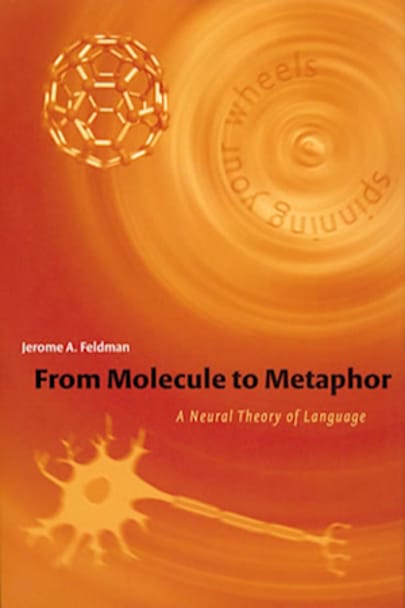In From Molecule to Metaphor, Jerome Feldman proposes a theory of language and thought that treats language not as an abstract symbol system but as a human biological ability that can be studied as a function of the brain, as vision and motor control are studied. This theory, he writes, is a “bridging theory” that works from extensive knowledge at two ends of a causal chain to explicate the links … the links between. Although the cognitive sciences are revealing much about how our brains produce language and thought, we do not yet know exactly how words are understood or have any methodology for finding out. Feldman develops his theory in computer simulations—formal models that suggest ways that language and thought may be realized in the brain. Combining key findings and theories from biology, computer science, linguistics, and psychology, Feldman synthesizes a theory by exhibiting programs that demonstrate the required behavior while remaining consistent with the findings from all disciplines.
After presenting the essential results on language, learning, neural computation, the biology of neurons and neural circuits, and the mind/brain, Feldman introduces specific demonstrations and formal models of such topics as how children learn their first words, words for abstract and metaphorical concepts, understanding stories, and grammar (including “hot-button” issues surrounding the innateness of human grammar). With this accessible, comprehensive book Feldman offers readers who want to understand how our brains create thought and language a theory of language that is intuitively plausible and also consistent with existing scientific data at all levels.
more



As promised, Jerome Feldman delivers a comprehensive, detailed theory that takes us from individual neuron function to the way the brain’s neural system works in language use, as it is currently known, all the way through embodied thought, grammar, language, and conceptual metaphor. Though there is obviously much more research to be done at most of these higher levels. This book reminded me how reading always depends on both writer and reader. I first read it some years back, but was much more impressed after reading it again recently. My point is that the changes that made me appreciate this material more were obviously in me, not the book; the main change being, perhaps, greater interest in the detail described.
One section of particular interest:
“I believe there is a plausible story about how a discreet evolutionary change could have given early hominids a simulation capability that helped start the process leading to our current linguistic abilities. Mammals in general exhibit at least two kinds of involuntary simulation behavior–dreams and play.” […] “Given that mammals do exhibit involuntary displacement in dreams, it seems that only one evolutionary adaptation is needed to achieve our ability to imagine situations of our choosing. Suppose that the mammals involuntary simulation mechanisms were augmented by brain circuits that could explicitly control what was being imagined, as we routinely do. […] Now, hominids who could do detached simulations could relive the past, plan for the future and be well on their way to simulating other minds. Understanding other minds would then provide a substrate for richer communication and all the benefits that accrue from the use of mental spaces.”
I’m a bad scholar and amateur scientist, possibly, in that I always seem to have an ax to grind. My particular ax is symbolic thought as the primary evolutionary agent of change in human thinking. These last few decades, scientists have come up with a number of abilities they have hypothesized could have led to language. One of these is imagination: the ability to simulate. Another candidate is recursive thought. Either imagination or recursive thought, they have speculated in various times and places, could have been the ability that led to language and the modern human manner of thought. To me, this seems a case of violation of Occam’s Razor: entities in the chain of cause and effect are multiplied unnecessarily. When I read the section on simulation in From Molecule to Metaphor, in which the author suggested that controlled simulation could have been the key that led to language, I was momentarily stunned, then thought: Couldn’t that be backwards? What else is one function of language but controlling simulation? Isn’t that what we’re learning from embodied models of cognition? Language activates many of the same areas that are activated by the perceptions and actions of real situations. Perhaps symbol use is the way we extended our nascent natural abilities to simulate, not the other way round. Protolanguage, or the start of one in a lexicon, could have given our ancestors concrete signposts to kick start displacement and the simulation process. I believe Derek Bickerton first said something similar to this about displacement in More Than Nature Needs, his terrific explanation of Wallace’s Problem; that is, the existence of the large evolutionary gap between human abilities and those of all other creatures. And, in the same vein, I believe that symbol use and displacement (grammar, in particular) could have kick started recursivity.
At any rate, From Molecule to Metaphor is an excellent exposition of embodied language functioning at all levels, and I heartily recommend it.